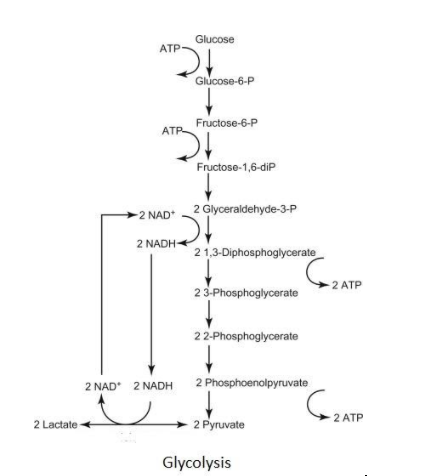
How many pyruvates are produced by oxidation of 1 glucose molecule?
(A) Two
(B) Three
(C) One
(D) Four
Answer
565.5k+ views
Hint: Glycolysis is derived from Greek word and it is a universal pathway in the living cells. The glycolysis cycle is often referred to as the EMP pathway. It is a sequence of reactions in which the glucose is Converted to pyruvate.
Complete step by step solution:
Glycolysis is a sequence of reaction in which the glucose are converted to pyruvate or lactate with the production of ATP. During the process of glycolysis around 4 ATP are formed out of which 2 are consumed.
Pyruvate is produced when the process of glycolysis occurs in the presence of oxygen. Two pyruvate molecules are produced by the oxidation of one glucose molecule as shown in the given figure:

Hence the correct answer is option (A).
Additional information:
Salient features of glycolysis:
-It takes place in the cell of the body. The enzymes of this pathway are existing in the fragment of the cell.
-Glycolysis takes place in the absence of the oxygen which means that it is a type of anaerobic reaction or it can also take place in the presence of oxygen which means that it is also a type of aerobic reaction. Lactate is the end product when glycolysis takes place in the absence of oxygen and pyruvate is the end product when glycolysis takes place in the presence of oxygen.
Note: Glycogen is the storage form of glucose. The degradation of the glycogen in the muscles meets the immediate fuel requirement where the glycogen present in the liver maintains the level of glucose in blood.
Complete step by step solution:
Glycolysis is a sequence of reaction in which the glucose are converted to pyruvate or lactate with the production of ATP. During the process of glycolysis around 4 ATP are formed out of which 2 are consumed.
Pyruvate is produced when the process of glycolysis occurs in the presence of oxygen. Two pyruvate molecules are produced by the oxidation of one glucose molecule as shown in the given figure:

Hence the correct answer is option (A).
Additional information:
Salient features of glycolysis:
-It takes place in the cell of the body. The enzymes of this pathway are existing in the fragment of the cell.
-Glycolysis takes place in the absence of the oxygen which means that it is a type of anaerobic reaction or it can also take place in the presence of oxygen which means that it is also a type of aerobic reaction. Lactate is the end product when glycolysis takes place in the absence of oxygen and pyruvate is the end product when glycolysis takes place in the presence of oxygen.
Note: Glycogen is the storage form of glucose. The degradation of the glycogen in the muscles meets the immediate fuel requirement where the glycogen present in the liver maintains the level of glucose in blood.
Recently Updated Pages
Master Class 12 English: Engaging Questions & Answers for Success

Master Class 12 Business Studies: Engaging Questions & Answers for Success

Master Class 12 Economics: Engaging Questions & Answers for Success

Master Class 12 Social Science: Engaging Questions & Answers for Success

Master Class 12 Maths: Engaging Questions & Answers for Success

Master Class 12 Chemistry: Engaging Questions & Answers for Success

Trending doubts
What are the major means of transport Explain each class 12 social science CBSE

Which are the Top 10 Largest Countries of the World?

Draw a labelled sketch of the human eye class 12 physics CBSE

Explain sex determination in humans with line diag class 12 biology CBSE

The pH of the pancreatic juice is A 64 B 86 C 120 D class 12 biology CBSE

Explain sex determination in humans with the help of class 12 biology CBSE




